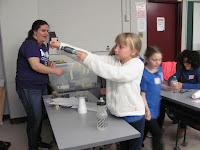The first 30 minutes of the meeting were Patrol Time, and each patrol worked on a different activity:
- Trillium Patrol - "Where Is It?" - outdoor scavenger hunt and puzzle game
- Rose Patrol - "Skipping" - did individual and group skipping, as well as other games using skipping ropes
- Pansy Patrol - "Camp On A Plate" - used natural objects, cardstock and paper to build campsites on Styrofoam plates
- Daffodil Patrol - "Don't Stress It" - discussed ways of dealing with stress and popped balloons to represent letting go of the things that cause them stress
The main part of our meeting started with our usual opening and an active game - Hotdog Tag. After this, we said good-bye to our 3rd Year Guides as they joined the Pathfinders and Rangers to do some planning for activities during the next three months.
Our activities for the 1st & 2nd Year Guides and the Brownies were based on the "How Girls Can Help" Challenge offered by the Agnes Baden-Powell Appreciation Society. The girls had to work in Patrols to complete a variety of activities. We had 8 activity cards, divided into four categories - Active, Arts, Service and World - and each Patrol was challenged to work on at least one card from each category.
Active (Yellow)
Activity #1 - Invent and play an active game with your Patrol. Write down the instructions. What equipment is needed? How many people can play? (Supplies: Paper, Pencils)
Activity #2 - You can probably tie a reef knot, but what about a sheet-bend, bowline or clove hitch? See if each person in your Patrol can learn two new knots. (Supplies: Knot Cards, Rope)
Arts (Pink)
Activity #1 - As a Patrol, create a skit, story or dance to perform at campfire.
Activity #2 - Is there a badge you think Guides should earn? Create a design for the badge and write down what you would need to do to earn it. (Supplies: Paper, Pencils, Markers)
Service (Green)
Activity #1 - Design a 'Be Prepared' Kit for camping. What will you put in it? When would you use it? How will it help you to stay safe? (Supplies: Paper, Pencils, Markers)
Activity #2 - What do you think should be in a First Aid Kit for Guides? Work together as a Patrol to make a list. (Supplies: Paper, Pencils, Markers)
World (Blue)
Activity #1 - Use your engineering skills to design a better paper airplane. See whose design will fly the furthest. (Supplies: Paper, Paperclips)
Activity #2 - Each part of the World Badge and World Flag has a special meaning. Find out what they are and create an activity or game to teach others what you have learned. (Supplies: Guide Handbook, Paper, Pencils, Markers)
We ended the evening by sharing skits and games, followed by Taps.
We ended the evening by sharing skits and games, followed by Taps.
































